1996 PONTIAC BONNEVILLE change wheel
[x] Cancel search: change wheelPage 89 of 387
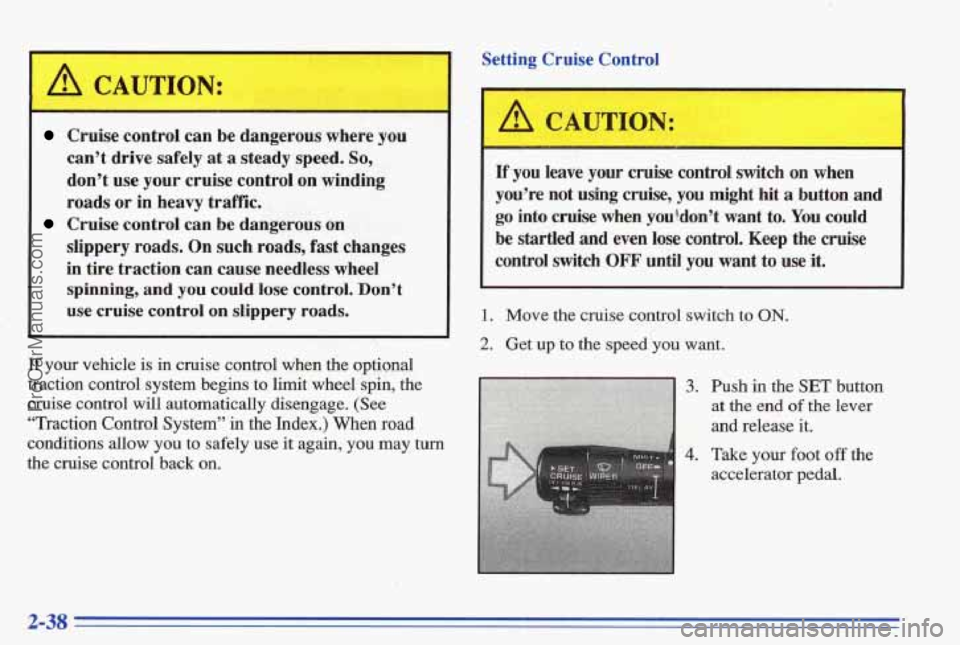
A CAUTION:
~~~ ~ ~ ~ ~~~ ~
Cruise control can be dangerous where you
can’t drive safely at
a steady speed. So,
don’t use your cruise control on winding
roads or in heavy traffic,
slippery roads. On such roads, fast changes
in tire traction can cause needless wheel
spinning, and you could lose control. Don’t
use cruise control
on slippery roads.
Cruise control can be dangerous on
If your vehicle is in cruise control when the optional
traction control system begins to limit wheel spin, the
cruise control
will automatically disengage. (See
“Traction Control
System” in the Index.) When road
conditions allow you to safely use it again, you may turn
the cruise control back
on.
Ifyou leave your cruise control switch on when
you’re not using cruise, you might hit
a button and
go into cruise when youldon’t want to. You could
be startled and even
lose control. Keep the cruise
control switch
OFF until you want to use it.
1. Move the cruise control switch to ON.
2. Get up to the speed you want.
3.
4.
Push in the SET button
at the end of the lever
and release it.
Take your foot
off the
accelerator pedal.
’ 2-38
ProCarManuals.com
Page 174 of 387
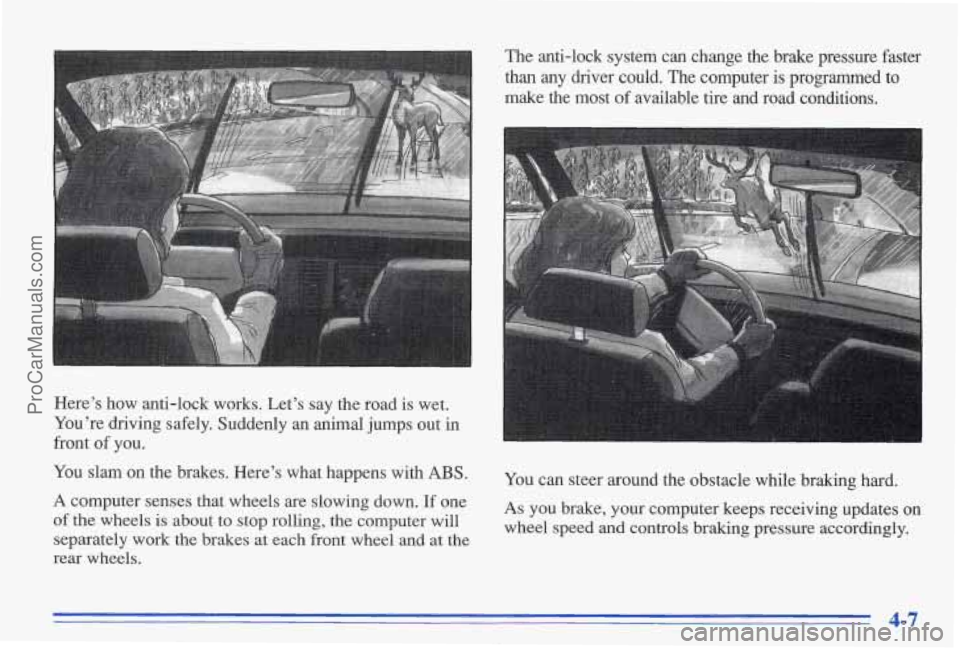
Here’s how anti-lock works. Let’s say the road is wet.
You’re driving safely. Suddenly
an animal jumps out in
front
of you.
You slam on the brakes. Here’s what happens with
ABS.
A computer senses that wheels are slowing down. If one
of the wheels is about to stop rolling, the computer will
separately work the brakes
at each front wheel and at the
rear wheels. The anti-lock system can change the brake pressure faster
than
any driver could. The computer is programmed to
make the most of available tire and road conditions.
You can steer around the obstacle while braking hard.
As you brake, your computer keeps receiving updates on
wheel speed and controls braking pressure accordingly.
ProCarManuals.com
Page 177 of 387
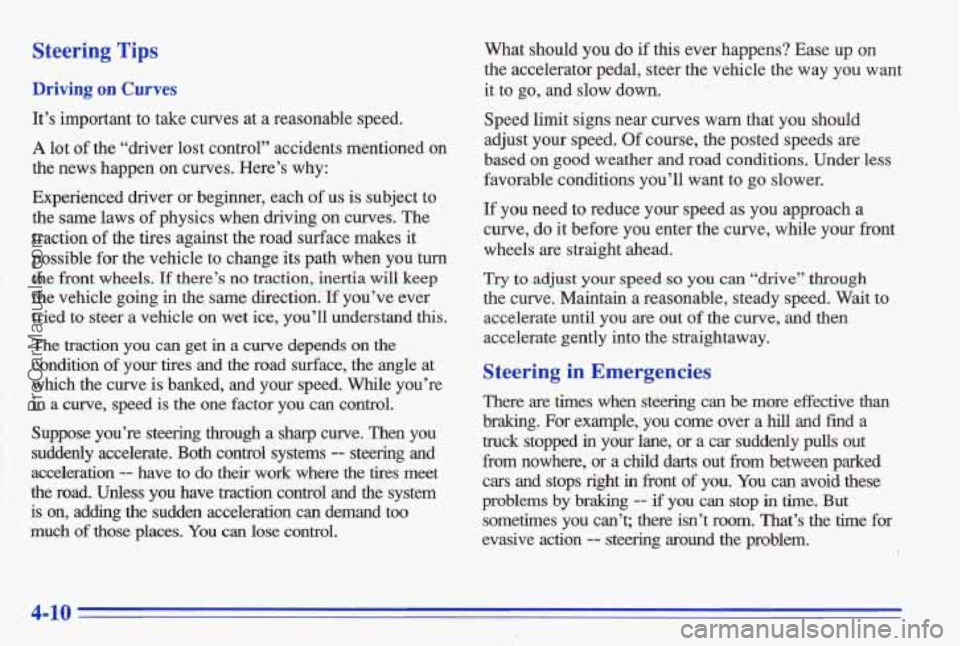
Steering Tips
Driving on Curves
It’s important to take curves at a reasonable speed.
A lot of the “driver lost control” accidents mentioned on
the news happen on curves. Here’s why:
Experienced driver or beginner, each of us
is subject to
the same laws
of physics when driving on curves. The
traction
of the tires against the road surface makes it
possible for the vehicle to change its path when you turn
the front wheels.
If there’s no traction, inertia will keep
the vehicle
going in the same direction. If you’ve ever
tried to steer a vehicle on wet ice, you’ll understand this.
The traction
you can get in a curve depends on the
condition
of your tires and the road surface, the angle at
which the curve is banked, and your speed. While you’re
in a curve, speed is the one factor you can control.
Suppose you’re steering through a sharp curve. Then you
suddenly accelerate. Both control systems
-- steering and
acceleration -- have to do their work where the tires meet
the road. Unless you have traction control and the system
is on, adding
the sudden acceleration can demand too
much
of those places. You can lose control. What should you
do if this ever happens? Ease up on
the accelerator pedal, steer the vehicle the way you want
it
to
go, and slow down.
Speed limit signs near curves warn that you should
adjust your speed.
Of course, the posted speeds are
based
on good weather and road conditions. Under less
favorable conditions you’ll want to
go slower.
If you need to reduce your speed
as you approach a
curve, do it before you enter the curve, while your front
wheels are straight ahead.
Try to adjust your speed so you can “drive” through
the curve. Maintain a reasonable, steady spied. Wait
to
accelerate until you are out of the curve, and then
accelerate gently into the straightaway.
Steering in Emergencies
There are times when steering can be more effective than
braking. For example, you come over a hill and find a
truck stopped
in your lane, or a car suddenly pulls out
from nowhere, or a child darts out from between parked
cars and stops right
in fi-ont of you. You can avoid these
problems by
braking -- if you can stop in time. But
sometimes you can’t; there isn’t room.
That’s the time for
evasive action
-- steering around the problem.
4-10
ProCarManuals.com
Page 181 of 387
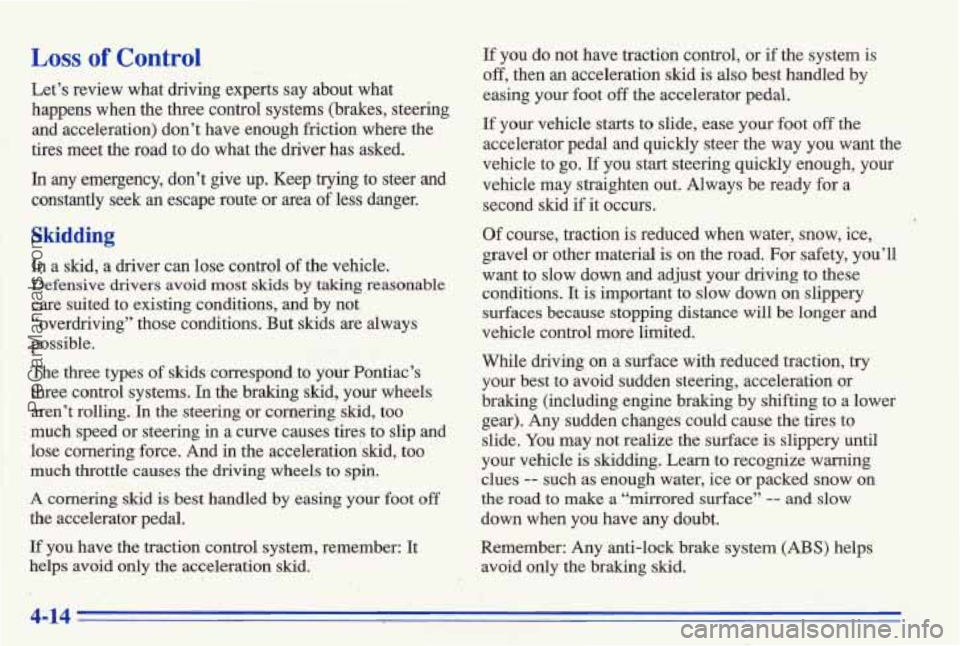
Loss of Control
Let’s review what driving experts say about what
happens when the three control systems (brakes, steering and acceleration) don’t have enough friction where the
tires
meet the road to do what the driver has asked.
In any emergency, don’t give up. Keep trying to steer and
constantly seek
an escape route or area of less danger.
Skidding
In a skid, a driver can lose control of the vehicle.
Defensive drivers avoid most skids by taking reasonable
care suited to existing conditions, and by not
“overdriving” those conditions. But skids
are always
possible.
The three types of skids correspond to your Pontiac’s
three control systems. In the braking skid, your wh’eels
aren’t rolling.
In the steering or cornering skid, too
much speed or steering in a curve causes tires to slip and lose cornering force. And
in the acceleration ‘skid, too
much throttIe causes the driving wheels
to spin.
A cornering skid is best handled by easing your foot off
the accelerator pedal.
If you have the traction control system, remember: It
helps avoid
only the acceleration skid.
If you do not have traction control, or if the system is
off, then an acceleration skid is also best handled by
easing your foot off the accelerator pedal.
If your vehicle starts to slide, ease your foot off the
accelerator pedal and quickly steer the way you want the
vehicle to
go. If you start steering quickly enough, your
vehicle may straighten out. Always be ready for a second skid if it occurs.
Of course, traction
i,s reduced when water, snow, ice,
gravel or other material
is on the road. For safety, you’ll
want to slow down and adjust your driving to these
conditions.
It is important to slow down on slippery
surfaces because stopping distance will
be longer and
vehicle control more limited.
While driving on a surface with reduced traction, try
your best to avoid sudden steering, acceleration or
braking (including engine braking by shifting to a lower
gear). Any sudden changes could cause the tires to
slide. You may not realize the surface
is slippery until
your vehicle is skidding. Learn to recognize warning
clues
-- such as enough water, ice or packed snow on
the road to make a “mirrored surface” -- and slow
down when you have any doubt.
Remember: Any anti-lock brake system
(ABS) helps
avoid only
the braking skid.
4-14
ProCarManuals.com
Page 199 of 387
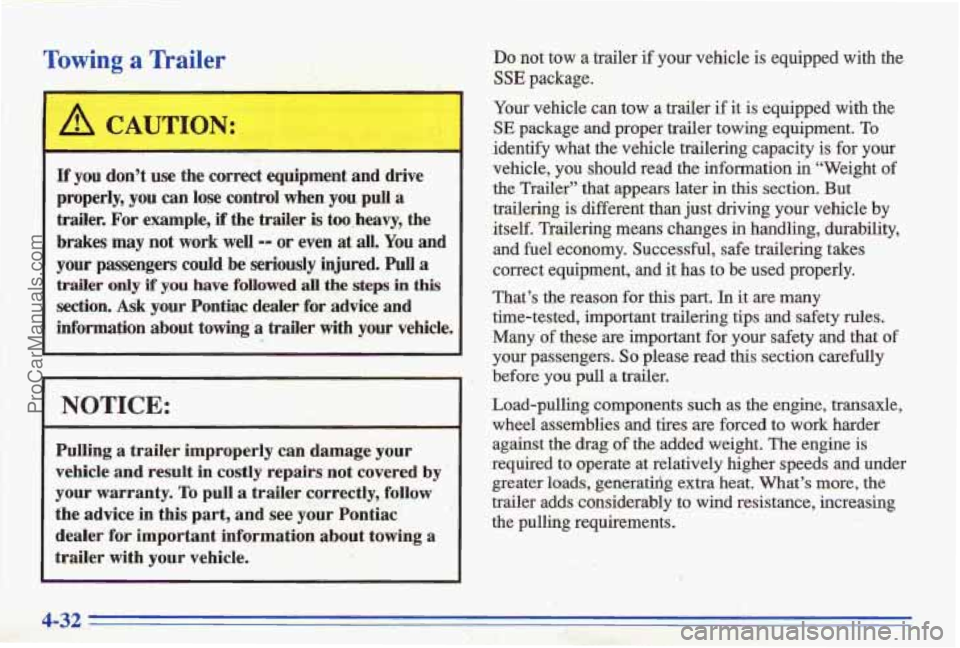
Towing a Trailer
If you don’t use the correct equipment and drive
properly,
you can lose control when you pull a
&der. For example, if the trder is too,heavy, the
brakes
may not work well -- or even at all. You and
your passengers could be’ seriously injured. Pull a
trailer only if you have followed all the steps in this
section. Ask your Pontiac dealer for advice and
information about towing
a trailer with your vehicle.
’ I NOTICE:
~
Pulling a trailer improperly can damage your
vehicle and result in costly repairs not covered by
your warranty.
To pull a trailer correctly, follow
the advice in this part, and see your Pontiac
dealer- for important information about towing a
trailer
with your vehicle.
Do not tow a trailer if your vehicle is equipped with the
SSE package.
Your vehicle can tow a trailer if it is equipped with the
SE package and proper trailer towing equipment. To
identify what’the vehicle ‘trailering capacity is for your
vehicle, you should read the information i.i “Weight of
the Trailer” that appears
later in this section. But
trailehg is different
than just driving your vehicle by
itself. Trailering means changes
in handling;durability,
and fuel economy. Successful, safe trailering takes
correct equipment, and it has
to be used properly.
That’s
the reason for this part. In it are many
time-tested, important trailering tips and safety rules.
Many of these are important for your safety and that of
your passengers. So please read this section carefially
before
you pull a trailer.
Load-pulling_components
such as the engine, transaxle,
wheel assemblies
and tires are forced to work harder
against
the drag of the added weight. The engine is
required to operate at relatively higher speeds and under
greater
loads, generatkig extra heat, What’s more, the
trailer adds considerably to
wind resistance, increasing
the pulling requirements, -
4-32 ‘
.. ProCarManuals.com
Page 212 of 387
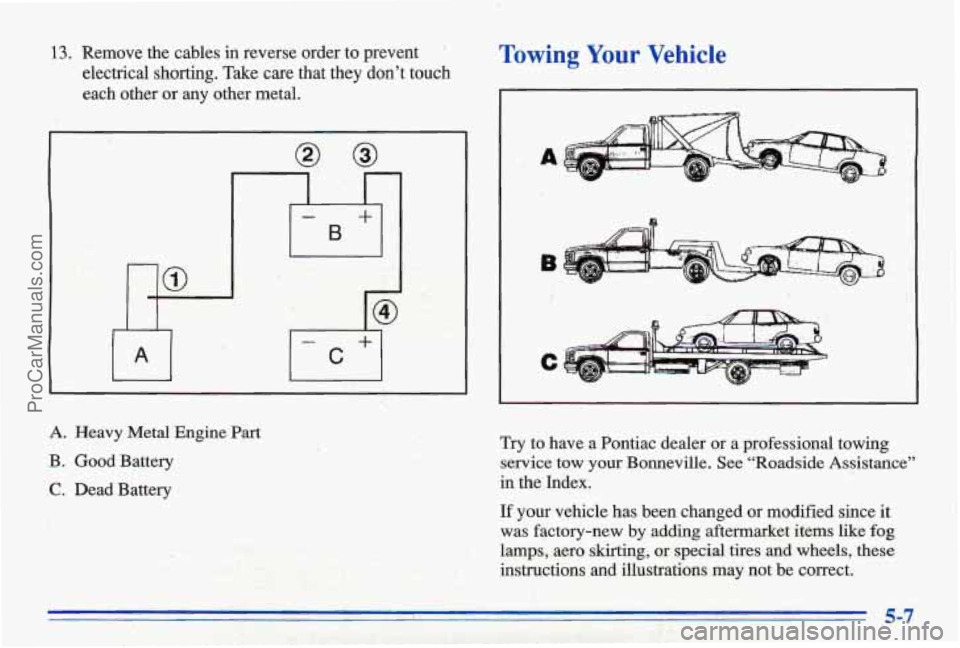
e.;: :I ; I. ‘ -.‘w .I , . ;. I .- > ..
Towing Your Vehicle 13. Remove the cables in reverse order to prevent ’
electrical shorting. Take care that they don’t touch
each other or any other metal.
I
.-
A
B
A. Heavy Metal Engine Part
B. Good Battery
C. Dead Battery Try
to have a Pontiac dealer or a professional towing
service tow your Bonneville. See “Roadside Assistance”
in the Index.
If your vehicle has been changed or modified since it
was factory-new
by adding aftermarket items like fog
lamps, aero skirting, or special tires and wheels, these
instructions and illustrations may not be correct.
- . 5-7
ProCarManuals.com
Page 231 of 387

Changing a Flat Tire
If a tire goes flat, avoid fwther tire and wheel damage
by driving slowly to a level place, Turn on your hazard
warning flashers.
A CAUTION:
Changing a tire can cause an injury. The vehicle
can slip
off the jack and roll over you or other
people. You and they could be badly injured.
-Find a level place to change your tire. To help
prevent the vehicle from moving:
1. Set the parking brake firmly.
2. Put the shift lever in PARK (P).
3. lbrn off the engine.
To b'e even more certain the vehicle won't move,
you can put blocks
at. the front and rear of the
tire farthest away from the one being changed.
That would
be the tire on the other side of the
vehicle, at the opposite end.
The following steps will tell you how to use the jack and
c;lhange a tire.
ProCarManuals.com
Page 237 of 387
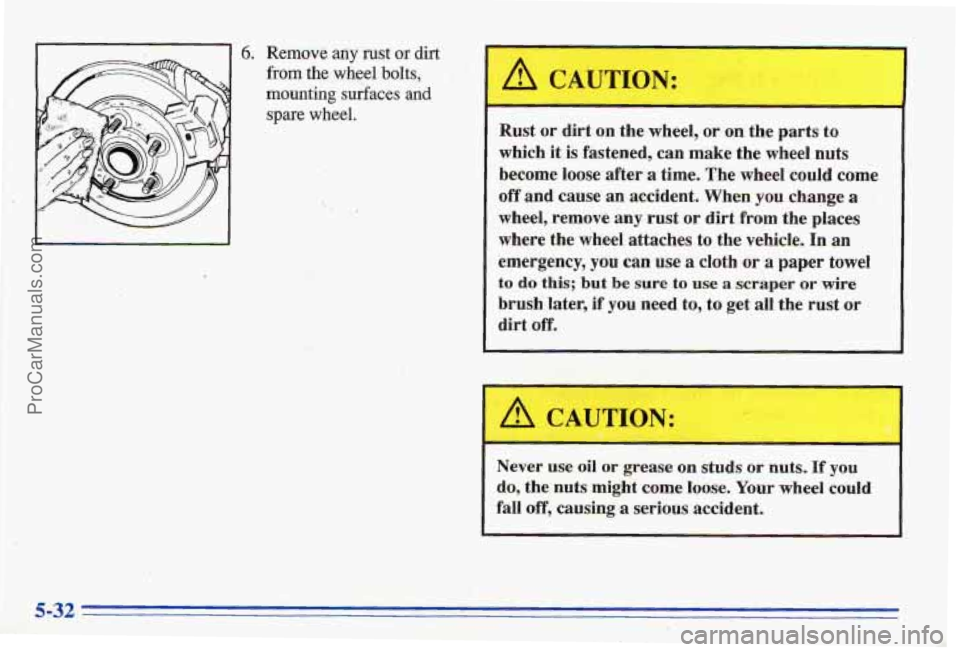
I 1r= U. Remove any rust or dirt
from the wheel bolts,
mounting surfaces and
spare wheel.
....
/r CAUTION:
Rust or dirt on the wheel, or on the parts to
which
it is fastened, can make the wheel nuts
become loose after
a time. The wheel could come
off and cause an accident. When you change a
wheel, remove any rust or dirt from the places
where the wheel attaches to the vehicle.
In an
emergency, you can use a cloth or a paper towel
to do this; but be sure to use a scraper or wire
brush later, if you need to, to get all the rust or
dirt off.
I A CAUTION: a
Never use oil or grease on studs or nuts. If you
do, the nuts might come loose. Your wheel could
fall
off, causing a serious accident.
I
,
: ,. -.
ProCarManuals.com